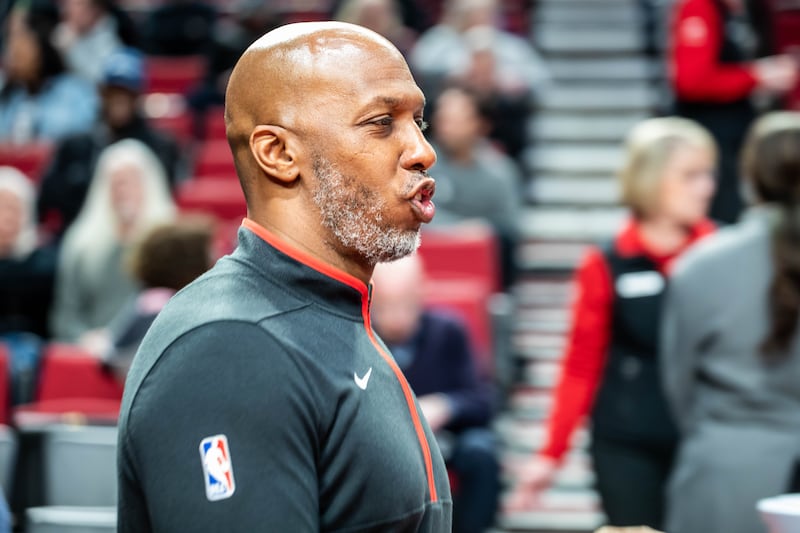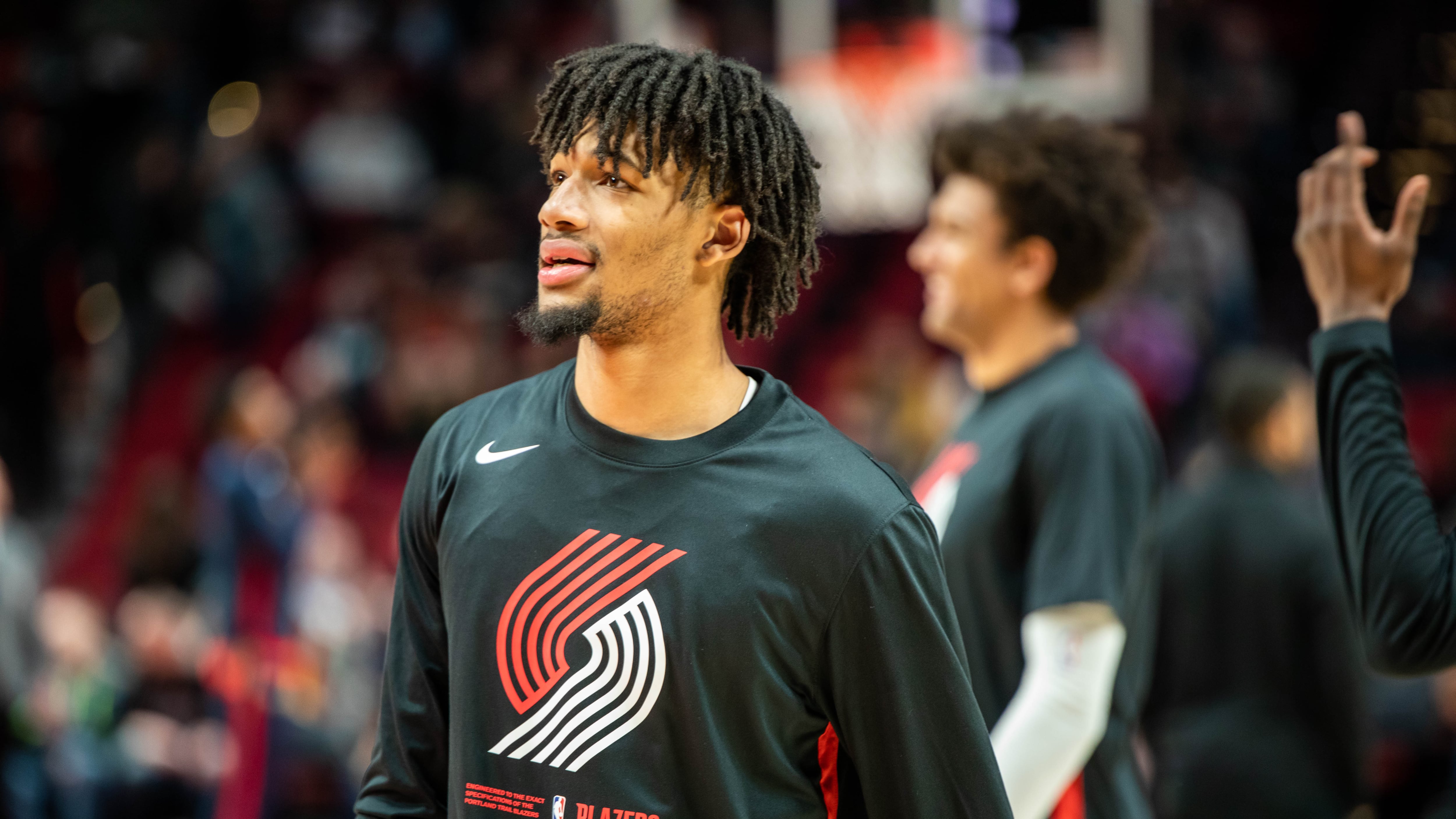It took the Trail Blazers less than two weeks to confirm what we all assumed: They are a rebuilding team. The baby Blazers have won two of their first five games, vacillating between overwhelmed befuddlement and exuberant confidence on a quarter-by-quarter basis.
Portland’s 110-101 victory over the Detroit Pistons on Wednesday typified the roller-coaster ride of youth in the NBA. Shaedon Sharpe was the high point of the evening. The second-year guard exploded for 26 points in the second half, spurring a comeback from an 18-point deficit.
Encouragingly, Sharpe drew 10 foul shots in the process, and his aggressive play seemed to coax several benefit-of-the-doubt foul calls out of the officials. Despite not recording an assist on Wednesday, he’s also demonstrated an improved ability to find holes in collapsing defenses and completing passes at remarkable angles. Combine the offensive prowess with good instincts on defense and there’s every reason to be extremely excited about the Shaedon era.
In contrast to Sharpe, Portland’s newest blue-chip rookie, Scoot Henderson, has mostly struggled. Truly abysmal misses from deep and awkward forced shots around the hoop have created some ugly box scores. In particular, Henderson’s line against the 76ers last week featured more fouls and turnovers than points and assists.
It’s admittedly a disappointment that he’s not drawing any Rookie of the Year buzz, given the pre-draft hype. But Henderson is already showing enough signs of growth to avoid even a yellow alert. He recorded 11 points and seven assists against the Pistons before exiting early with a sprained ankle. It was easily his best performance thus far.
The reality, however, is that as long as Henderson is shooting 9.5% on 3-pointers, defenders can go under screens on pick and rolls. That cuts off passing or driving lanes and renders moot Scoot’s top skills: downhill athleticism and pick-and-roll decision-making. Other hyper-athletic NBA point guards have succeeded with subpar 3-point shots (e.g., Russell Westbrook and Ja Morant), but spacing will be a challenge for Henderson and the Blazers in the short term.
Encouragingly, Henderson seems to be developing a rapport with Deandre Ayton, Portland’s new starting center. They burned the Pistons for an alley-oop in the opening seconds of Wednesday’s game, and this play highlights how Ayton’s size meshes with Scoot’s ability to read defenses.
The Blazers will look for Henderson, and others, to create more opportunities for Ayton going forward. After averaging 7.25 field goal attempts across the first four games, Ayton had 13 shot attempts in the win over the Pistons. Finding ways to facilitate shot attempts for their center will be a key factor in Portland’s offense—Ayton struggles as a traditional back-to-the-basket big man but can score in bunches when he receives the ball in position to take rapid and dynamic action against rotating defenses. Wednesday’s game was a step in the right direction for the Scoot-to-Deandre connection. (Ayton also had five steals on Wednesday night and is averaging 14 rebounds per game.)
Other bright spots for the Blazers have included Malcolm Brogdon and Toumani Camara. Brogdon is averaging 18 points off the bench and, along with Sharpe, has been one of Portland’s only reliable outside shooters. General manager Joe Cronin will likely be looking to deal the reigning sixth man of the year to a contender, but until then he remains a veteran anchor for the bench. Camara has been the rare second-round pick who breaks into an opening-night rotation. His stat line has not been impressive, but his energy on defense and nose for the ball will turn him into a fan favorite.

Despite those positive signs, the Blazers’ glaring weaknesses have put them at a disadvantage and will likely continue to undermine their positive growth on most nights. As of now, this is not a playoff team, or even a play-in team. The offense, which scores 103.8 points per 100 possessions, is tied for 27th of 30 in the league. Henderson isn’t the only one struggling from beyond the arc: The team is dead last in 3-point percentage (29.3%). The lack of shooting prowess has allowed defenses to sink in toward the hoop, creating spacing nightmares across the court on most possessions. As a result, the Blazers often fall back on overdribbling and isolation, leading to contested jump shots for Jerami Grant, Brogdon and whoever else ends up stuck with the ball.
The outcome is a team that’s dead last in assists per 100 possessions. Anfernee Simons returning from injury in a few weeks will help, but ultimately, if the opposition plays competent defense, the Blazers will be relying on the aforementioned contested jumpers to win games. Not a recipe for success.
Defensively, the Blazers have shown signs of life in the half court. They hold opponents to 109.3 points per 100 possessions—good for No. 13 in the league. But they are Nos. 25 and 28, respectively, in surrendering fast-break points and points in the paint per game. Not a great sign for a team that hopes to rely on youth and a switch-heavy frenetic defensive game plan. The opening game of the season against the Clippers was particularly bad, with L.A. scoring repeatedly on dunks and layups to jump out to a huge lead in the opening minutes. The Pistons, similarly, ran the Blazers off the court in the second quarter on Wednesday, scoring repeatedly in transition.
In short, there’s a reason the Blazers have lost more games than they have won. And there’s a reason they looked completely outmatched in blowout losses to the 76ers and Clippers, both playoff teams. The team has no identity—which isn’t really a surprise in the first month after the franchise centerpiece skips town.
But, so far, the wheels have not entirely fallen off and key players are developing. If you can ignore the particularly ugly quarters (and games), that’s pretty solid for a rebuilding team. The overall quality of play is going to vary widely from night to night, even quarter to quarter. When you buy seats for the Grizz this weekend—or any night in the coming month—you’re essentially buying a scratch-off ticket.

